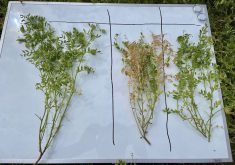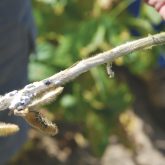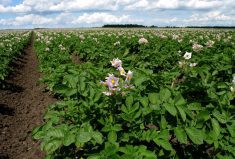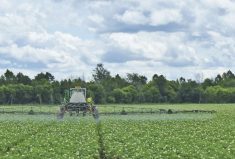Timing is everything for many things — including when to spray fungicides on wheat. A new study provides more information on what time is best, including on whether it’s no time at all.
The study, published in a recent edition of the Canadian Journal of Plant Science, was conducted by Sheri Strydhorst. At the time of the study, Strydhorst was an agronomic research scientist with Alberta Agriculture and Forestry. She is now an agronomy research specialist with the Alberta Wheat Commission (AWC) and Alberta Barley. The research was supported by Saskatchewan, Wheat Development Commission and Alberta Innovates, with in-kind support from Agriculture and Forestry, Syngenta and the University of Alberta.
Tan spot, stripe rust, Septoria nodorum blotch (SNB) and Septoria tritici blotch (STB) are problem diseases of concern in Alberta. Fusarium head blight (FHB) is slowly on the rise, but at present is mostly found in the south.
Read Also

Are you ready for farm succession?
What motivates some farmers to make a succession plan while others don’t seem worried.
For these diseases, previous research has found that application of fungicide at growth stage “BBCH 61-63” (start of flowering) can reduce disease in the head and foliage, as well as DON toxin in the grain.
However, Strydhorst says there are many reports of farmers applying fungicides much earlier, presumably to manage diseases proactively or reduce application costs.
“Some farmers tank mix fungicides with herbicides or plant growth regulators and apply them together. Before our study, there was limited data on whether these early fungicide applications are effective in wheat, but that data had found earlier is not generally better.”
Variety differences?
The study also looked at whether traditional fungicide timing strategies are effective on modern wheat cultivars with improved genetic disease resistance. Strydhorst says there has been little research into the effect of STB, SNB, tan spot or FHB on their yields and quality, and how they’re affected by fungicide timing.
The cultivars in the study were two of the most common, AAC Brandon and AAC Viewfield. Strydhorst says that while both have an intermediate rating for leaf spot disease in the 2019 Alberta Seed Guide, they were still prone to foliar leaf spot diseases in this study. “That is, they both exhibited a response to fungicide application when disease pressure was high.”
Over the growing seasons of 2018 and 2019, Strydhorst and her team applied up to three separate fungicides at growth stage BBCH 22-23 (herbicide timing), early- to mid-season stage BBCH 30-32 (plant growth regulator timing), “traditional” timing at stage BBCH 39-45 (flag leaf), head timing at BBCH 61-63 (anthesis). The effects of these applications were compared with a non-treated control. The fungicides were Tilt 250 E, Trivapro A+B and Prosaro XTR.
Not always needed
Strydhorst notes that study results apply to Alberta, where the research was conducted, and that when there is less precipitation and therefore less disease pressure, response to fungicides could be minimal or nonexistent. Over the two seasons, only half of the study sites responded to fungicides. Those that did respond had more overall precipitation, more precipitation in July/August and higher relative humidity (RH).
The study says site-years where environmental conditions were not favourable for disease development, and thus where fungicide was unnecessary, were characterized by low RH (57.7-63.7 per cent) and average growing season precipitation of 175 mm (6.9 inches).
“If disease incidence and severity are low throughout the growing season, such as we observed at the non-responsive sites with less growing season precipitation (121-214 mm or 4.8-8.4 inches), reduced May and June precipitation (85 per cent of the long-term average) and lower RH (57.7-63.7 per cent), there may not be a need to spray fungicide.”
Regarding application timing, the study showed that when growing season precipitation (194-364 mm or 7.6-14.3 inches) and RH (65.4-74.0 per cent) are near the long-term averages, the best time to apply fungicides to minimize yield and quality loss is at growth stages BBCH 39-45 (flag leaf) and BBCH 61-63 (anthesis).

When fungicides were applied early at BBCH 22-23 (herbicide timing) and BBCH 30-32 (PGR timing), leaf spot disease severity in early August was 50 per cent greater than if applications were delayed until BBCH 39-45 (flag leaf). Later applications at BBCH 61-63 (start of flowering) reduced leaf spot disease severity compared with earlier application, but the reduction was not always statistically significant.
Overall, the study confirmed earlier results that showed fungicide application at the flag leaf stage (BBCH 39-45) represents the optimal timing for control of leaf spot diseases in AAC Brandon and AAC Viewfield.
However, application at that time as well application at the BBCH 61-63 (FHB timing, at start of flowering/anthesis) resulted in thousand- kernel weight 5.2 per cent greater and yield 9.3 per cent greater than when fungicide was applied earlier. Strydhorst says this conclusion supports earlier research results that very early fungicide applications provided no yield or quality benefits, even on new CWRS wheat varieties with improved genetic resistance to cereal diseases.
Days to maturity, test weight, protein and DON levels were not affected by any treatment in this study. The percentage of fusarium-. damaged kernels was unsurprisingly much higher (2.5 times) than in non-responsive (drier) site years. However, these levels were still much lower than levels in the eastern Prairies. As FHB becomes more well-established throughout Alberta, these trends could change.
As to whether FHB and leaf spot disease can be controlled at the same time, Strydhorst notes that other research published by MacLean et al. in 2018 found that anthesis fungicide applications provided adequate leaf spot disease control and optimized FHB control at the same time.















